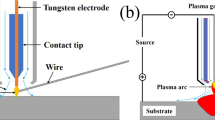Abstract
The mechanism of porosity formation and its suppression methods in laser formation of aluminum alloy have been studied using a 4kW fiber laser to weld 5A06 aluminum alloy with SAl-Mg5 filler. It was found that the porosity formation is closely related to the stability of the keyhole and fluctuation of the molten pool in the laser welding aluminum alloy. The filling wire increased the instability of the keyhole and weld pool, thus further increasing the amount of gas cavities in the joint. Prefabrication of a suitable gap for the butt joint can provide a natural passage for the flow of the liquid metal, which can weaken, and even completely eliminate the disturbance of the filling wire on the formation of keyhole. The gap can also provide a passage for the escape of the bubble. Thus, this method can greatly decrease the sheet’s susceptibility to porosity. Moreover, for a thin sheet, if the power of the laser is sufficient to form a keyhole with stable penetration through the weld sheet, a weld bead without porosity can also be obtained because closing the keyhole is almost impossible.
Similar content being viewed by others
References
A. F. M. Arif, Effect of input variability on the quality of laser shock processing, Journal of Mechanical Science and Technology, 23(10) (2009) 2603–2611.
Z. L. Lu, J. H. Liu, Y. S. Si, and C. Z. Y, Characteristics of complicated AISI316L automobile components manufactured by powder/metallurgy, Journal of Mechanical Science and Technology, 23(7) (2009) 1924–1931.
L. Quintino, A. Costa, R. Miranda, D. Yapp, V. Kumar and C. J. Kong, Welding with high power fiber lasers-A preliminary study, Materials and Design, 28 (2007) 1231–1237.
T. Sibillano, A. Ancona, V. Berardi, E. Schingaro, G. Basile, P. M. Lugara, A study of the shielding gas influence on the laser beam welding of AA5083 aluminium alloys by in-process spectroscopic investigation, Optics and Lasers in Engineering, 44 (2006) 1039–1051.
L. Yu, K. Nakata and J. Liao, Weld porosity in fibre laser weld of thixomolded heat resistant Mg alloys, Science and Technology of Welding and Joining, 14(6) (2009) 554–558.
J. Zhou and H. L. Tsai, Porosity formation and prevention in pulsed laser welding, Journal of Heat Transfer, 129(8) (2007) 1014–1024.
I. Kawaguchi, S. Tsukamoto, G. Arakane and K. Nakata, Suppression of porosity by laser power modulation — Study on prevention of porosity in high power CO2 laser welding (report 3), Yosetsu Gakkai Ronbunshu/Quarterly Journal of the Japan Welding Society, 25(2) (2007) 328–335.
I. Kawaguchi, S. Tsukamoto, G. Arakane and H. Honda, Characteristics of high power CO2 laser welding and porosity suppression mechanism by nitrogen shield — Study on high power laser welding phenomena- (report 1), Yosetsu Gakkai Ronbunshu/Quarterly Journal of the Japan Welding Society, 23(2) (2005) 259–264.
L. M. Liu, G. Song, G. L. Liang and J. F. Wang, Pore formation during hybrid laser-tungsten inert gas arc welding of magnesium alloy AZ31B—mechanism and remedy, Materials Science and Engineering, A 390 (2005) 76–80.
A. Haboudou, P. Peyre, A. B. Vannes and G. Peix, Reduction of porosity content generated during Nd:YAG laser welding of A356 and AA5083 aluminium alloys, Materials Science and Engineering, A 363 (2003) 40–52.
T. Hayashi, K. Matsubayashi, S. Katayama, N. Abe, A. Matsunawa and A. Ohmori, Reduction mechanism of porosity in tandem twin-spot laser welding of stainless steel, Yosetsu Gakkai Ronbunshu/Quarterly Journal of the Japan Welding Society, 20(2) (2002) 228–236.
N. Seto, S. Katayama and A. Matsunawa, Porosity formation mechanism and reduction method in CO2 laser welding of stainless steel, Welding International, 16(6) (2002) 451–460.
M. Kutsuna, Q. Yan, Study on porosity formation in laser welds of aluminium alloys, IIW-doc IV-683-97.
A. Matsunawa, J. D. Kim and S. Katayama, Porosity formation in laser welding — mechanisms and suppression methods, Proc. ICALEO’ 97, LIA., (1997) 73–82.
A. Matsunawa, N. Seto, J. D. Kim, M. Mizutania and S. Katayama, Dynamics of keyhole and molten pool in high power CO2 laser welding, Proceedings of SPIE., 3888 (2000) 34–45.
J. W. Yoon, Y. S. Lee, K. D. Lee and K. Y. Park, Effect of filler wire composition on Nd:YAG laser weld ability of 6061 aluminum alloy. Materials Science Forum, 475–479(2005) 2591–2594.
T. Jokinen and V. P. Kujanpää, High power Nd:YAG laser welding in manufacturing of vacuum vessel of fusion reactor, Fusion Engineering and Design, 69 (2003) 349–353.
A. S. Salminen and V. P. Kujanpää, Effect of wire feed position on laser welding with filler wire, Journal of Laser Applications, 15(1) (2003) 2–10.
A. S. Salminen, Effects of filler wire feed on the efficiency of laser welding. First International Symposium on High-Power Laser Macro-processing, Proceedings of SPIE., 4831 (2003) 263–268.
Z. Sun and M. Kuo, Bridging the joint gap with wire feed laser welding, Journal of Materials Processing Technology, 87 (1999) 213–222.
C. Schinzelt, B. Hohenberger, F. Dausinger and H. Hugel, Laser welding of aluminum extended processing potential by different wire positions, In High-Power Lasers in Manufacturing, Proceedings of SPIE., 3888 (2000) 380–391.
Author information
Authors and Affiliations
Corresponding author
Additional information
This paper was recommended for publication in revised form by Associate Editor Yong Tae Kim
Yang-chun Yu received his M.A. degree in Material Processing Engineering from Huazhong University of Science and Technology (HUST), China, in 2004. He is currently studying for a PhD at the School of Materials Science and Engineering at HUST in Wuhan, China. His research interests main in laser materials processing.
Chun-ming Wang is an associate professor at the School of Materials Science and Engineering, Huazhong University of Science and Technology (HUST), China. His research interest is laser materials processing. At least 15 of his papers have already published.
Rights and permissions
About this article
Cite this article
Yu, Y., Wang, C., Hu, X. et al. Porosity in fiber laser formation of 5A06 aluminum alloy. J Mech Sci Technol 24, 1077–1082 (2010). https://doi.org/10.1007/s12206-010-0309-4
Received:
Revised:
Accepted:
Published:
Issue Date:
DOI: https://doi.org/10.1007/s12206-010-0309-4




